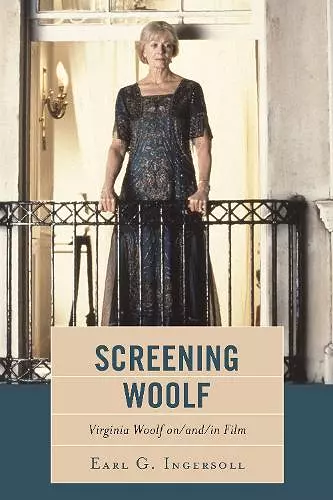Screening Woolf
Virginia Woolf on/and/in Film
Format:Paperback
Publisher:Fairleigh Dickinson University Press
Published:17th Apr '18
Currently unavailable, and unfortunately no date known when it will be back
This paperback is available in another edition too:
- Hardback£75.00(9781611479706)

As the subtitle indicates, this book has three majors concerns. The first and most important concern is an examination of the film adaptations of Woolf’s novels—To the Lighthouse, Orlando, and Mrs. Dalloway—in the order the films were released. This is the heart of the matter, a fairly conventional effort to acknowledge film reviews as well as the criticism of academicians in film or literature as a starting point for a fresh view of these three film adaptations. Since many film specialists prefer that no film ever be adapted from literary fiction and many literature specialists have similarly wished that their favorite novels had never been filmed, the effort to mediate the two sides can be challenging. Of the three films, To the Lighthouse is the least successful, tending toward the old Masterpiece Theater mode of attempting to be faithful to the “source text,” to use the term of the film theorist Robert Stam, but missing the essence of the novel. Director Sally Potter’s Orlando is cinematically the most venturesome and attractive, although some Woolf readers condemn Potter’s erasure of Woolf’s intent to celebrate her affair with Vita Sackville-West (whose son Nigel Nicolson called Woolf's Orlando “the longest and most charming love-letter in literature”). Mrs. Dalloway tends toward the Merchant/Ivory style of treating literary masterworks—indeed, the film credits include a debt of gratitude to the producer/director partnership—and is generally carried by the star power of Vanessa Redgrave, although it is difficult to imagine her having a crush on another young woman, even at eighteen. The book’s second concern is Woolf’s interest in what she would call “the cinema.” As a member of Bloomsbury, she saw and participated in the discussion of the cinema, especially avant-garde films, which she considered to be more the future of cinema than film adaptations, upon which she heaped great scorn for their ravenous, if not rapacious, consumption of vulnerable literary fiction such as Leo Tolstoy’s Anna Karenina. Woolf specialists such as Leslie Hankins proclaim her one of the earliest and most significant British film theorists for the brilliant essay “The Cinema” (1925), as film was just beginning to establish itself as art and not merely popular entertainment. The third concern is a complex effort to explore the David Hare/Stephen Daldry film...
Ingersoll (emer., SUNY, College at Brockport), who has also written about film adaptations of the novels of E. M. Forster (Filming Forster, CH, Oct'12, 50-0767), acknowledges that addressing the connections between film and Virginia Woolf is a less straightforward endeavor than are most case studies of adaptation. In contrast to Forster's, Woolf’s connection to film is not simply that of the author of a source text. First, she differed from many of her contemporaries (Forster, for example) in that she actively engaged film, writing both critically and theoretically about it and its relationship to the novel. Second, only a small number of her novels have been directly adapted to the screen, with varying success. Ingersoll analyzes these in depth. And third, Woolf appears as a character (via Nicole Kidman) in the acclaimed film adaptation of Michael Cunningham’s The Hours. This trifold relationship accounts for Ingersoll’s subtitle, "on/and/in," which…on examination is apt. Ingersoll’s investigation of the connections, as he terms it, between Woolf and film is thoughtful and useful scholarship for those interested in English literature and film studies. Summing Up: Recommended. Lower-division undergraduates through faculty. * CHOICE *
ISBN: 9781611479720
Dimensions: 228mm x 152mm x 15mm
Weight: 308g
198 pages